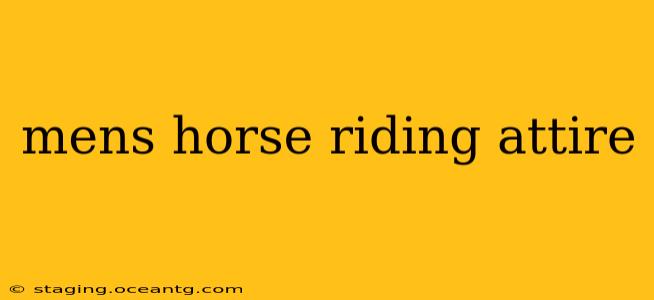Horse riding, whether for pleasure or competition, demands specialized attire for both safety and comfort. This guide delves into the essential components of men's horse riding attire, addressing common questions and offering insights to help you choose the right gear.
What are the essential pieces of men's horse riding clothing?
The core components of men's equestrian attire prioritize safety and functionality. These include:
-
Riding Helmet: This is non-negotiable. A properly fitted riding helmet, certified to safety standards (like ASTM/SEI), is crucial to protect your head from falls. Consider helmets with ventilation for comfort during warmer rides.
-
Riding Boots: These provide ankle support and a secure grip in the stirrups. Choose tall boots (reaching at least mid-calf) for optimal protection. Leather riding boots are classic and durable, while synthetic options offer more affordable alternatives.
-
Riding Breeches/Jodhpurs: Designed for comfort and freedom of movement, these close-fitting trousers are made from durable, breathable fabrics. They often feature reinforced seat patches for added durability.
-
Riding Shirt/Jacket: A long-sleeved shirt made from breathable fabric offers protection from the sun and chafing. A riding jacket adds an extra layer of warmth and protection, especially during colder weather. Many riders opt for shirts made from moisture-wicking material to stay comfortable.
-
Gloves: Riding gloves improve grip on the reins and protect your hands from blisters and chafing.
What type of riding boots are best for men?
The best type of riding boot depends on your riding discipline and budget.
-
Leather Riding Boots: These are the traditional choice, known for their durability, longevity, and superior support. However, they require more maintenance.
-
Synthetic Riding Boots: These offer a more affordable and lower-maintenance alternative to leather boots. While not as durable as leather, they provide adequate support and protection for many riders.
-
Paddock Boots: Shorter than full riding boots, paddock boots are a convenient option for casual riding and schooling. They usually require chaps or gaiters for added protection.
What should men wear under their riding breeches?
Comfort and moisture-wicking are key considerations for undergarments worn beneath riding breeches. Avoid cotton, which retains moisture and can lead to chafing. Instead, opt for moisture-wicking athletic base layers made from materials like polyester or merino wool. These fabrics draw sweat away from your skin, keeping you comfortable and dry during your ride.
What are the different types of riding helmets for men?
Riding helmets are categorized by their safety standards and features:
-
ASTM/SEI Certified Helmets: These helmets meet stringent safety standards and are crucial for protecting your head during falls.
-
All-Season Helmets: Designed for year-round use, these incorporate ventilation features for warmer weather and potentially offer additional liners or covers for colder conditions.
-
Specialized Helmets: Certain disciplines, such as eventing or jumping, might require specialized helmets with additional features like improved impact protection.
How do I choose the right size riding helmet for men?
Proper helmet fit is paramount for safety. A helmet that's too loose won't provide adequate protection, while one that's too tight can be uncomfortable and restrictive. Always try a helmet on before purchasing, ensuring it fits snugly but comfortably. Many retailers offer professional fitting services to ensure a perfect fit.
This guide provides a foundation for understanding men's horse riding attire. Remember that personal preference and riding discipline play significant roles in choosing your equipment. Always prioritize safety and comfort when selecting your riding gear. Consult with experienced riders or equestrian professionals for personalized advice.
